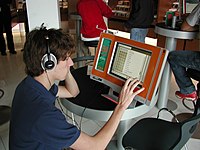
Photo from wikipedia
In the present paper, the effective damping properties of a symmetric foam-core sandwich beam with composite face plates reinforced with coated fibers is studied. A glass fiber-epoxy composite with additional… Click to show full abstract
In the present paper, the effective damping properties of a symmetric foam-core sandwich beam with composite face plates reinforced with coated fibers is studied. A glass fiber-epoxy composite with additional rubber-toughened epoxy coatings on the fibers is considered as the material of the face plates. A micromechanical analysis of the effective properties of the unidirectional lamina is conducted based on the generalized self-consistent method and the viscoelastic correspondence principle. The effective complex moduli of composite face plates with a symmetric angle-ply structure are evaluated based on classical lamination theory. A modified Mead-Markus model is utilized to evaluate the fundamental modal loss factor of a simply supported sandwich beam with a polyurethane core. The viscoelastic frequency-dependent behaviors of the core and face plate materials are both considered. The properties of the face plates are evaluated based on a micromechanical analysis and found to implicitly depend on frequency; thus, an iterative procedure is applied to find the natural frequencies of the lateral vibrations of the beam. The optimal values of the coating thickness, lamination angle and core thickness for the best multi-scale damping behavior of the beam are found.
Journal Title: Applied Composite Materials
Year Published: 2018
Link to full text (if available)
Share on Social Media: Sign Up to like & get
recommendations!